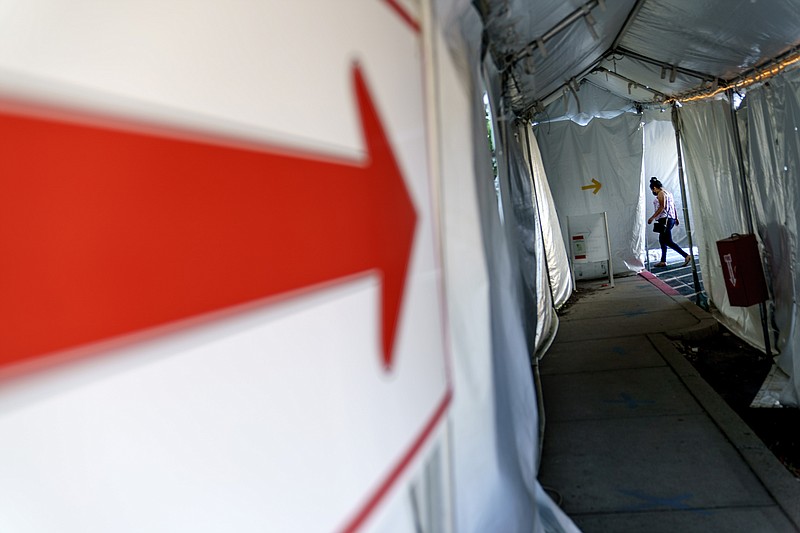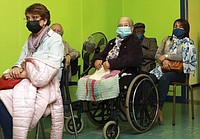The U.S. is facing an ever-growing surplus of coronavirus vaccine, looming vaccine expiration dates and lagging demand even as the developing world clamors for doses to stem covid-19 infections and variants of the disease continue to spread.
The stockpiles are becoming more daunting each week. Oklahoma has more than 700,000 doses on shelves but is administering only 4,500 a day and has 27,000 Pfizer and Moderna doses that will expire at the end of the month.
Millions of Johnson & Johnson doses nationwide were to expire this month, but the government extended their expiration dates by six weeks, and some leaders say it will be difficult to use them up even by then.
Million-dollar prizes, free beer and marijuana, raffled-off hunting rifles and countless other giveaways around the country have failed to significantly move the needle on vaccine hesitancy.
[CORONAVIRUS: Click here for our complete coverage » arkansasonline.com/coronavirus]
"We really cannot let doses expire. That would be a real outrage, given the need to get vaccines to some undervaccinated communities in the U.S. and the glaring gap in vaccinations and the inequity of vaccinations that we have globally," said Dr. Kirsten Bibbins-Domingo, chairwoman of epidemiology and biostatistics at the University of California, San Francisco.
Amid the glut, the White House has announced plans to share 80 million doses globally by the end of June, and buy 500 million more doses of the Pfizer vaccine and donate them to 92 lower-income countries and the African Union over the next year.
The U.S. averaged about 870,000 new injections per day at the end of last week, down sharply from a high of about 3.3 million a day on average in mid-April, according to the Centers for Disease Control and Prevention.
President Joe Biden wants to have 70% of the adult U.S. population at least partially vaccinated by July 4. But the U.S. could well fail to meet that target. As of Friday, 64% of Americans 18 and older had had at least one dose, by the CDC's count.
Some states, especially in the Northeast, have reached that 70% goal for adults, while places like Mississippi and Alabama are nowhere close. Mississippi, in fact, has been transferring large quantities of vaccine to other states and the federal government.
[Video not showing up above? Click here to watch » https://www.youtube.com/watch?v=Ix7sh7lOEvc]
With demand stronger in Maine and Rhode Island, the two states received 32,400 doses each from Mississippi, where only about one-third of the state is at least partially vaccinated. Mississippi has also transferred 800,000 doses to a federal vaccine pool. The state has seen demand plunge to levels not seen since the opening weeks of the vaccine rollout, with only 18,400 doses administered there this week.
Mississippi State Health Officer Dr. Thomas Dobbs said Friday that the state health department was more than happy to help states in the Northeast.
"In Mississippi, if people don't understand how important it is to keep alive, we want to protect other Americans," he said.
Each week, states are allotted a number of doses from the government and are allowed to order shots from that. But more states have stopped placing orders for new doses in recent weeks because they have such a large inventory.
Those skipping the vaccine include Benjamin Schlink of Pearl, Miss., who said he believes he is healthy enough to fight the illness.
"The way I look at it, I don't worry about it, because God is in control," he said. "If God wants you to have it, you'll have it."
Gayle Charnley, 69, said some of her neighbors in the small town think she should get the shot, but she is not planning on it.
"They're just forcing them on people as fast as they can get them, and we don't know what the long-term effects are going to be," she said.
[Gallery not loading above? Click here for more photos » arkansasonline.com/612covid19/]
Hundreds of millions of vaccine doses have been administered around the world with intense safety monitoring, and few serious risks have been identified.
ENTICEMENTS FOR SHOTS
States have come up with creative ways to entice people to get vaccinated.
In North Carolina, $25 cash cards helped draw people to vaccination clinics, but even so, the state isn't ordering any new doses from the government for the second week in a row. Instead, the state has given back 1.2 million doses.
In Colorado, which has given more than 175,000 doses back to the federal pool, there's a million-dollar lottery, and drag queens have begun beckoning people at clinics during Pride Month. In New Mexico, the nation's biggest lottery grand prize, $5 million, halted a downward trend in vaccinations and may have even caused a slight improvement, officials said. Washington state allowed marijuana stores to offer free joints this week to entice people to get vaccinated.
While incentive programs may not have sent vaccination rates soaring, they are still a worthwhile tool for states working through the difficult "last mile" of a marathon, said Dr. Nirav Shah, head of the Maine Center for Disease Control and Prevention and president of the Association of State and Territorial Health Officers.
About one-quarter of the hundreds of people who responded to North Carolina's cash-card giveaway said it was key in their decision to get shots that day.
"If states are able to prevent chains of transmission that would have otherwise landed people in the ICU on a ventilator, missing weeks of work, keeping their family out of school, if we can avoid a handful of those incidents, then these programs will have been worth it," Shah said.
Several states aren't ordering new vaccines from the government, including Alabama, Delaware, New Hampshire, New Jersey, Utah and Oklahoma. Other states, such as Iowa and Nevada, are still ordering new doses but in dramatically reduced amounts.
Still, Shah said the nation's vaccine rollout is moving much more quickly than he expected, and he welcomed efforts to expand distribution to hard-pressed regions like Africa.
"One of the things that the pandemic has illustrated is that we are not safe, as a state, as a country, as a globe, until everywhere is safe," he said.
Some of the demand slowdown in the U.S. is a natural part of the rollout process, experts said. In Massachusetts, 68% of people have first doses, and the mass vaccination sites are shutting down as officials shift to harder-to-reach places, such as drug treatment centers.
In particular, demand has been especially low for the Johnson & Johnson vaccine, a one-shot, easy-to-store formula that held great promise because of its convenience, but whose rollout has been hurt by links to a rare blood clot disorder and contamination problems at a Baltimore factory.
More than 100 million doses of the Johnson & Johnson vaccine and at least 70 million doses of the AstraZeneca vaccine were put on hold after Emergent discovered in March that its workers had contaminated a batch of Johnson & Johnson's vaccine with a key ingredient used to produce AstraZeneca's.
Federal regulators have told Johnson & Johnson that about 60 million doses of its coronavirus vaccine produced at a Baltimore factory cannot be used because of possible contamination, according to people familiar with the situation.
The Food and Drug Administration said Friday it will allow about 10 million doses to be distributed in the United States or sent to other countries, but with a warning that regulators cannot guarantee that Emergent BioSolutions, the company that operates the plant, followed good manufacturing practices. The agency has not yet decided whether Emergent can reopen the factory, which has been closed for two months because of regulatory concerns, the people said.
The Johnson & Johnson doses administered in the United States so far were manufactured at the firm's plant in the Netherlands, not by Emergent.
In a statement, Johnson & Johnson cast Friday's decision as "progress in our continued efforts to make a difference in this pandemic on a global scale." And Robert G. Kramer, president and CEO of Emergent, said in a statement: "We are pleased that these initial doses of the Johnson & Johnson COVID-19 vaccine will be available to protect millions of people from this deadly disease."
ATTENTION ON CHILDREN
Meanwhile, regulators are turning their attention to younger children and the level of proof needed before authorizing shots for children as young as 6 months.
Many members of a panel that advises the FDA on vaccines argued Thursday that faster authorization should be an option because of uncertainties about virus variants and a potential fall surge in cases. The discussion was not centered on a particular vaccine, and it unfolded as Pfizer-BioNTech and Moderna conduct trials of their vaccines in children.
The Pfizer-BioNTech vaccine is already authorized for adolescents as young as 12, and Moderna announced Thursday that it had submitted an application to the FDA for authorization for adolescents. Executives from Pfizer and Moderna have said data showing whether their vaccines are effective in younger children is expected by fall.
However, the expert discussion included many points of disagreement and often strayed into currently unanswerable questions about the future, reflecting how the question about vaccines for children may become emotional and tricky in the fall. Because covid-19, rarely results in serious illness in young children, several of the advisers argued that a longer and more conventional review of the vaccine should take place.
But A. Oveta Fuller, associate professor of microbiology and immunology at the University of Michigan Medical School, said that as the country opens up, she fears that unvaccinated children who have been largely insulated from the virus would begin to bear the burden of the disease.
"We haven't seen it for the children because they have been isolated, or there are other mitigations," Fuller said at the meeting of vaccine advisers. As mitigation measures are relaxed, she said, the virus could take root in unvaccinated populations. "I think we are in an emergency situation, and we will be going into winter."
Children can suffer from a rare inflammatory condition after infection, and about 300 children and adolescents are among the nearly 600,000 people in the United States who have died of covid-19.
The risk to children varies with age. Data presented at the meeting showed that children under age 5 were less likely to be infected or to have illness with symptoms as compared with older children. But hospitalization rates -- though low compared with adults -- were similar.
The role that children play in transmission is still poorly understood, but Hannah Kirking, a medical epidemiologist at the respiratory viruses branch of the CDC, presented unpublished data that suggests children of all ages play a role similar to adults in transmission and infection.
"I very strongly believe that we need a vaccine for adolescents and children, but I want to be sure that the risk of the vaccine is lower than the risk of hospitalization" from covid-19, said Cody Meissner, an infectious-diseases physician at Tufts Medical Center, noting that vaccines can carry risks and young children have a very low risk of being hospitalized.
For full approval, the FDA would typically require six months of follow-up of 3,000 children ages 6 months to 12 years. But because of the health emergency, the agency has authorized coronavirus vaccines in other age groups based on two months of median follow-up of study participants. Granting emergency authorization would make it theoretically possible for children to have access to the vaccine as soon as this fall.
Several experts recommended that infants and toddlers be studied in slightly larger numbers given their especially low risk of covid-19 and because vaccine side effects that are manageable in adults, such as fever, could cause seizures.
Information for this article was contributed by Lindsay Whitehurst and Leah Willingham of The Associated Press; by Sharon LaFraniere, Noah Weiland and Sheryl Gay Stolberg of The New York Times; and by Carolyn Y. Johnson of The Washington Post.










